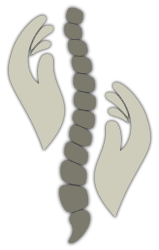What is Osteopathy?
Osteopathy is a gentle, holistic approach to treating a wide-range of problems with the body. Osteopathy uses hands-on techniques that aim to remove restrictions in the body’s structure to help restore optimal pain-free function. Osteopathy aims to work with the body, using a fine sense of touch, rather than against it with unnecessary force. Osteopath’s treat the body as a whole and address all of the tissues involved in a problem, not just the muscles and bones but importantly the connective tissues.
These connective tissues include the ligaments that hold the bones together, and the fascia that covers over and runs in between the muscles. In general, the longer a problem is present, the more the connective tissues get involved. Fortunately treating the connective tissues has a lasting effect, as tension in these tissues builds up over months and years, often in response to an injury or postural issues. Untreated connective tissue and joint restriction is sometimes why muscular tension can return after being loosened with techniques such as massage alone.
History of Osteopathy
Osteopathy is a system of manual medicine developed in the late 1800’s by Dr Andrew Taylor Still. Dr Still was a Medical Doctor and Surgeon in the United States, who became disenchanted with the practice of medicine, particularly after the tragic passing of his three children from infections. He felt this was a result of the inadequate medical care of the time.
He decided to move away from the harsh medicines used in his profession and devoted many years to studying the human body. He developed a system that focused on the body’s innate ability to heal itself and the influence that the physical structure of the body had on these healing abilities. He called this system ‘Osteopathy’ and launched his new treatment modality in 1874.
He realised that the structure and function of the body were inter-related, in that, if the musculoskeletal system was not correctly aligned and free moving, the internal and external workings of the body were not at their optimum. This could leave the body prone to disease and pain, and restrict its ability to heal itself. Conversely, if the internal workings of the body such as the cardiovascular, respiratory, gastrointestinal and lymphatic systems were not working well, this could be manifested in the musculoskeletal system.
Dr Still’s system used gentle hands-on techniques to treat the muscles, joints, connective tissue and also the vascular flow of blood and lymph. He put a strong emphasis on the body working as a whole, not as individual parts.
The Fine Sense of Touch
A key aspect of osteopathy which is a major focus of osteopathic training, is to ‘feel’ what the body is doing through the practitioner’s hands. This fine sense of touch is developed over many years so that the osteopath can detect not only muscular tightness, but also joint and connective tissue restriction deep within the body. Attention to the connective tissue is a key component of osteopathy, and includes the ligaments and fascia as mentioned above. The early osteopaths recognised that if the connective tissues were restored to the correctly balanced tension, the surrounding muscles would release also.
Styles of Osteopathy
The practice of Osteopathy can be divided into two major streams – structural and functional. The structural stream includes techniques such as soft tissue massage, deep tissue release and joint manipulation. At Central Osteopathy we believe joint manipulation should be done as gently as possible and only when required, and not if it will put the patient’s well-being at risk.
The functional stream includes the very gentle treatment styles of Balanced Ligamentous Tension, Fascial Release, and Cranial Osteopathy (see Cranial Osteopathy tab). These techniques were taught by the founder of Osteopathy, Dr AT Still, and developed further by osteopaths since, particularly William Garner Sutherland. The osteopaths at Central Osteopathy use a combination of these two streams to help the patient overcome their problem as quickly as possible and prevent it from returning.
Osteopathic Treatment
Osteopathic treatment firstly treats the body as a whole. Osteopaths recognise that all structures in the body are connected and that dysfunction in one area will eventually affect another. For example, a lower back problem will tighten the gluteal muscles in the hip, which then connect to the outer thigh and can alter the mechanics of the knee. Similarly, a foot, knee, hip or mid-back problem can affect your lower back. There are many, many connections and patterns like this that we deal with on a daily basis, but if the big-picture is kept in mind the problem can usually be resolved quickly.
Secondly osteopaths like to treat all of the tissues involved in the problem, including muscles, joints, connective tissue and if required the fluids of the body including blood flow, lymphatic flow and cerebrospinal fluid flow (see Cranial Osteopathy tab).
Get in Touch
At Central Osteopathy we treat all the tissues involved in a problem including muscles, joints and connective tissues so that the problem resolves quickly.

